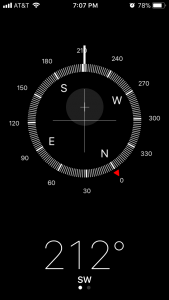Waxing Crescent
Feel free to use this for your project! (My recent data to help you!)
This observation of the Waxing Crescent was recorded on Monday, Oct. 25th, at 7:06 PM. The sun set about 30 minutes earlier (I could still see that setting-sun-glow just above the horizon, somewhat westerly at 253 degrees.) I looked left of where the sun was setting, because I know from our studies, that once the moon passes New Moon which was just a couple of days ago (I should look that up for the project…), that the moon is orbiting in prograde motion, that is counterclockwise from the Northern Hemisphere. At any rate, there it was – the moon, in the SW at 212 degrees. And this is exactly what is expected, that a waxing crescent of this size, is seen approximately 45 degrees from the sun and to “its left” in the sky. (By the way, I was hoping all of my students were outside looking at and photographing the same moon phase!)
Note: Students may use my data for this moon phase, but please the writing and so on needs to be different from my example!
Mrs. R 🙂
LOOK For the Moon
Students should be gathering data for Moon Phase Project during Conference Week.
- phase of moon
- drawing or photo
- direction, time, of both moon and sun (use compass, compass app, or general direction knowledge)
- narrative with science info to share with your group/or self to put into your project
- DUE: Nov. 14th
Simplified Guide to Moon Phases Project – Due Nov. 14 (gives more time!)
Create a presentation that teaches why the lunar phases change. (Easiest solution is to use Google Slides linked to student D6 email.
Should be 10 – 12 slides (minimum 2 slides per group member, list name on slides)
Show/Explain 8 major phases of the moon
Groups no more than 4; can work independently if choose to
Evidence can include: journal entries, photos, drawings, news article, video all of phases. Be sure to include time of sighting (AM or PM) and direction of sun and moon! (Critical for the explanation).
Add color, sound, creativity, model, etc.
Due date extended to Nov. 14! Presentations on Nov. 14, 15, & 16.
Helpful websites:
https://stardate.org/nightsky/moon
https://starchild.gsfc.nasa.gov/docs/StarChild/StarChild.html
Prezi not working in classrooms – Please choose Google Slides
Update… We’ve tried to log in to Prezi, but student settings are not allowing probably due to link to Youtube. We will instead use Google Slides which is shareable and linked to their drive. Sorry for the change!
Recent Test Grades and Moving On
I talked with students today about the importance of focusing on learning every day in the Science classroom, about taking a few moments often, daily?, to study what we’ve learned. I talked about students slowing down when taking a test (they had 53 minutes, and many finished in 15 minutes) to think about all of the answers (in a multiple choice test) and to choose the best one. It might be interesting to know, that students were also allowed to check their answers during the last 5 minutes of the test using their Science Journals (which I told them to bring) and the majority of students chose not to use these. (By the way, about 10 % of the students scored 100%.)
First test scores help students understand the types of questions to be prepared for (also, many questions were similar to Bellringer questions and closely discussed in class) – I always try to get kids very ready for tests, but some of this is a skill that kids need to develop (which, I believe, is what sixth grade is for), and to be more ready and focused in future learning. Also, I told kids to keep in perspective the total number of (data) points that will make up the final grade. (We’ve still got about 500 points to go, so one test score is not the only indicator for the final grade .) Although, some of you saw otherwise for a few hours today. Again, sorry for the Synergy mix up on my part.
Finally, extra credit is student directed and can take many forms. I can offer up to 10 points to each student, and no more than 2% of the final grade (and all regularly assigned work must be turned in). I suggested to one student to look up information about Alpha Centauri, our next closest star, and to present that information to the class. There will also be an opportunity to earn extra credit in our upcoming Moon Phases Project which we will launch on Tuesday.
I hope this allays some concerns, and puts us on to current learning so we don’t get bogged down still studying the sun – although it will keep on shining!
Alison Richards 🙂
Moon Phase Project Begins Next Week!
Please photograph full moon today if possible for upcoming project. Moonrise in Medford today at 7:11 PM
To photograph moon, be sure to have an object within the frame near the moon, examples a tree, roof line, bird, plane, street light; hold keys “near” moon in photo frame. Save pictures. More info to follow. Please do not send them to my email! 🙂
http://aa.usno.navy.mil/rstt/onedaytable?ID=AA&year=2017&month=10&day=5&state=OR&place=medford



